How to create a financial forecast for a fast food restaurant?
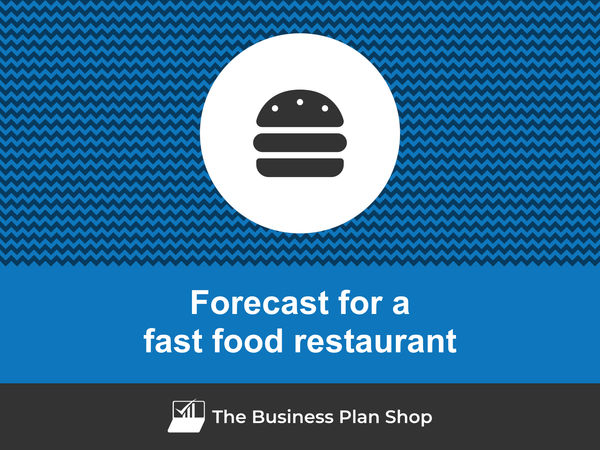
Developing and maintaining an up-to-date financial forecast for your fast food restaurant is key in order to maintain visibility on your business’s future cash flows.
If you feel overwhelmed at the thought of putting together a fast food restaurant financial forecast then don’t worry as this guide is here to help you.
We'll cover everything from: the main objectives of a financial forecast, the data you need to gather before starting, to the tables that compose it, and the tools that will help you create and maintain your forecast efficiently.
Let's get started!
Why create and maintain a financial forecast for a fast food restaurant?
In order to prosper, your business needs to have visibility on what lies ahead and the right financial resources to grow. This is where having a financial forecast for your fast food restaurant becomes handy.
Creating a fast food restaurant financial forecast forces you to take stock of where your business stands and where you want it to go.
Once you have clarity on the destination, you will need to draw up a plan to get there and assess what it means in terms of future profitability and cash flows for your fast food restaurant.
Having this clear plan in place will give you the confidence needed to move forward with your business’s development.
Having an up-to-date financial forecast for a fast food restaurant is also useful if your trading environment worsens, as the forecast enables you to adjust to your new market conditions and anticipate any potential cash shortfall.
Finally, your fast food restaurant's financial projections will also help you secure financing, as banks and investors alike will want to see accurate projections before agreeing to finance your business.
Need a solid financial forecast?
The Business Plan Shop does the maths for you. Simply enter your revenues, costs and investments. Click save and our online tool builds a three-way forecast for you instantly.

What information is used as input to build a fast food restaurant financial forecast?
A fast food restaurant's financial forecast needs to be built on the right foundation: your assumptions.
The data required to create your assumptions will depend on whether you are a new or existing fast food restaurant.
If you are creating (or updating) the forecast of an existing fast food restaurant, then your main inputs will be historical accounting data and operating metrics, and your team’s view on what to expect for the next three to five years.
If you are building financial projections for a new fast food restaurant startup, you will need to rely on market research to form your go-to-market strategy and derive your sales forecast.
For a new venture, you will also need an itemised list of resources needed for the fast food restaurant to operate, along with a list of equipment required to launch the venture (more on that below).
Now that you understand what is needed, let’s have a look at what elements will make up your fast food restaurant's financial forecast.
The sales forecast for a fast food restaurant
From experience, it usually makes sense to start your fast food restaurant's financial projection with the revenues forecast.
The inputs used to forecast your sales will include the historical trading data of your fast food restaurant (which can be used as a starting point for existing businesses) and the data collected in your market research (which both new ventures and existing businesses need to project their sales forward).
Your fast food restaurant's sales forecast can be broken down into two key estimates:
- The average price
- The number of monthly transactions
To assess these variables accurately, you will need to consider the following factors:
- Seasonal changes: As the weather changes, people's eating habits may also change. For example, during the summer months, people may be more likely to opt for cooler and lighter meals, such as salads, smoothies, and ice cream. This could potentially affect your average price and number of monthly transactions as customers may be willing to spend more on these items.
- Competitors: The presence of other fast food restaurants in the same area may affect your business's average price and number of monthly transactions. If there are many similar options nearby, customers may be more likely to compare prices and choose the cheaper option, which could lower your average price. Similarly, if a new and popular fast food chain opens nearby, it could potentially attract more customers and decrease your number of monthly transactions.
- Economic conditions: Changes in the economy, such as a recession or inflation, can have a significant impact on your business. During tough economic times, people may cut back on eating out and opt for more affordable options, which could decrease your average price and number of monthly transactions. On the other hand, during a booming economy, people may have more disposable income and be more willing to spend on fast food, leading to an increase in your average price and number of monthly transactions.
- Menu changes: Any changes made to your menu can also affect your business's average price and number of monthly transactions. For example, if you add new and trendy items to your menu, customers may be willing to pay more for them, increasing your average price. However, if you remove popular items or change the prices, it could potentially decrease your number of monthly transactions.
- Health trends: In recent years, there has been a growing trend towards healthier eating, which could potentially affect your business's average price and number of monthly transactions. If your fast food restaurant offers healthier options, such as salads and grilled items, you may attract health-conscious customers who are willing to pay more for these items, increasing your average price. However, if your menu mainly consists of unhealthy and high-calorie options, you may struggle to attract customers who are more health-conscious, leading to a decrease in your number of monthly transactions.
Once you have a sales forecast in place, the next step will be to work on your overhead budget. Let’s have a look at that now.
Need inspiration for your business plan?
The Business Plan Shop has dozens of business plan templates that you can use to get a clear idea of what a complete business plan looks like.

The operating expenses for a fast food restaurant
The next step is to estimate the costs you’ll have to incur to operate your fast food restaurant.
These will vary based on where your business is located, and its overall size (level of sales, personnel, etc.).
But your fast food restaurant's operating expenses should normally include the following items:
- Staff Costs: This includes wages, salaries, and benefits for all of your employees, such as cooks, cashiers, and managers.
- Accountancy Fees: You will need to hire an accountant to help you keep track of your financial records, file taxes, and provide financial advice.
- Insurance Costs: As a fast food restaurant, you will need to have insurance to protect your business from any potential risks, such as liability insurance for accidents or property insurance for damages.
- Software Licences: To run your restaurant smoothly, you will need to invest in software licenses for point of sale systems, inventory management, and accounting software.
- Banking Fees: You will have to pay fees for banking services, such as credit card processing fees and transaction fees for deposits and withdrawals.
- Food Costs: This includes the cost of ingredients and supplies needed to make your menu items, such as meat, vegetables, and packaging materials.
- Equipment Maintenance: Your kitchen equipment, such as grills, fryers, and refrigerators, will need regular maintenance and repairs to keep them running efficiently.
- Advertising and Marketing: To attract customers, you will need to invest in advertising and marketing campaigns, such as social media ads, flyers, and promotions.
- Rent or Mortgage: If you do not own your restaurant building, you will have to pay rent to the landlord. If you own the building, you will have to pay a mortgage.
- Utilities: This includes electricity, gas, and water bills for your restaurant, as well as internet and phone services.
- Cleaning and Sanitation: To maintain a clean and hygienic environment, you will need to invest in cleaning supplies, pest control services, and trash removal.
- Training and Development: It is important to provide ongoing training and development opportunities for your employees to improve their skills and knowledge.
- Licenses and Permits: You will need to obtain various licenses and permits to legally operate your fast food restaurant, such as a food service permit and health department permits.
- Credit Card Processing Fees: When customers pay with credit or debit cards, you will have to pay processing fees to the credit card company.
- Uniforms: If you require your employees to wear uniforms, you will need to cover the cost of purchasing and maintaining them.
This list is not exhaustive by any means, and will need to be tailored to your fast food restaurant's specific circumstances.
What investments are needed to start or grow a fast food restaurant?
Once you have an idea of how much sales you could achieve and what it will cost to run your fast food restaurant, it is time to look into the equipment required to launch or expand the activity.
For a fast food restaurant, capital expenditures and initial working capital items could include:
- Kitchen equipment: This includes items such as ovens, grills, fryers, and refrigerators. These are essential for preparing and storing food in a fast food restaurant.
- Point-of-sale (POS) system: A POS system is used for taking orders and processing payments. This is a crucial investment for ensuring smooth and efficient transactions in a fast food restaurant.
- Furniture and fixtures: This includes tables, chairs, and other furnishings for the dining area. These items not only provide a comfortable dining experience for customers but also contribute to the overall aesthetic of the restaurant.
- Signage and exterior design: The exterior of a fast food restaurant is often the first thing customers see, so it's important to make a good impression. This may include items such as a logo sign, drive-thru menu boards, and outdoor seating areas.
- Vehicles: For fast food chains with drive-thru or delivery services, investing in vehicles such as cars or bikes is necessary. These vehicles are used for transporting food and ensuring timely delivery to customers.
Again, this list will need to be adjusted according to the specificities of your fast food restaurant.
Need a convincing business plan?
The Business Plan Shop makes it easy to create a financial forecast to assess the potential profitability of your projects, and write a business plan that’ll wow investors.

The financing plan of your fast food restaurant
The next step in the creation of your financial forecast for your fast food restaurant is to think about how you might finance your business.
You will have to assess how much capital will come from shareholders (equity) and how much can be secured through banks.
Bank loans will have to be modelled so that you can separate the interest expenses from the repayments of principal, and include all this data in your forecast.
Issuing share capital and obtaining a bank loan are two of the most common ways that entrepreneurs finance their businesses.
What tables compose the financial plan for a fast food restaurant?
Now let's have a look at the main output tables of your fast food restaurant's financial forecast.
The profit & loss forecast
The forecasted profit & loss statement will enable you to visualise your fast food restaurant's expected growth and profitability over the next three to five years.
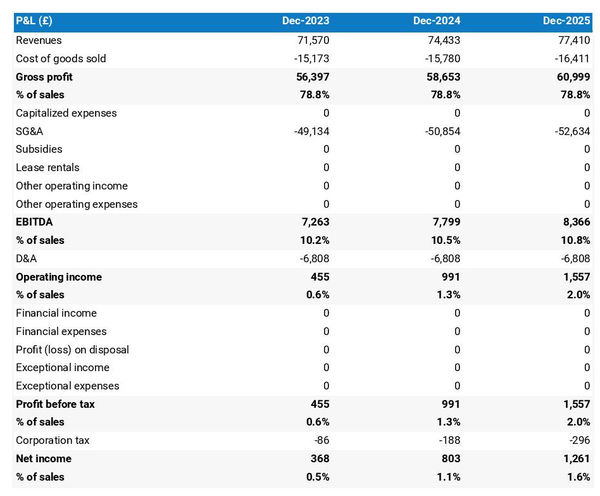
A financially viable P&L statement for a fast food restaurant should normally show:
- Sales growing above inflation
- Stable or expanding (ideally) profit margins
- A net profit
This will of course depend on the stage of your business: a new venture might be loss-making until it reaches its breakeven point in year 2 or 3, for example.
The projected balance sheet
Your fast food restaurant's forecasted balance sheet enables you to assess your financial structure and working capital requirements.
It is composed of three types of elements: assets, liabilities and equity:
- Assets: represent what the business owns and uses to produce cash flows. It includes resources such as cash, equipment, and accounts receivable (money owed by clients).
- Liabilities: represent funds advanced to the business by lenders and other creditors. It includes items such as accounts payable (money owed to suppliers), taxes due and loans.
- Equity: is the combination of what has been invested by the business owners and the cumulative profits and losses generated by the business to date (which are called retained earnings). Equity is a proxy for the value of the owner's stake in the business.
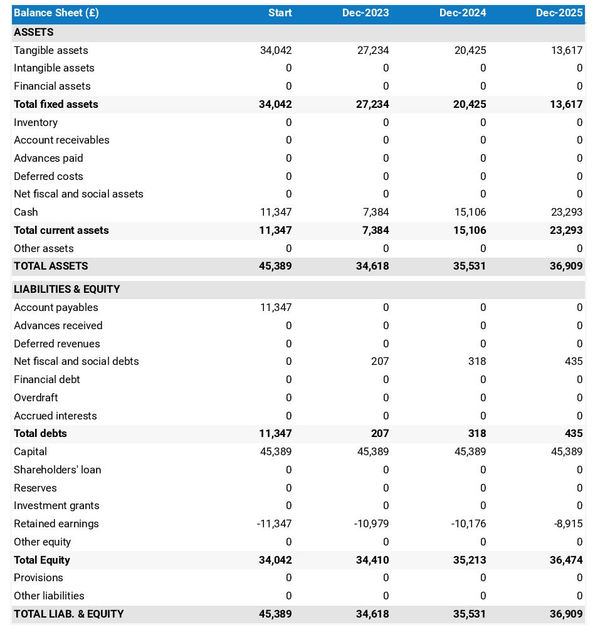
The cash flow projection
The cash flow forecast of your fast food restaurant will show how much cash the business is expected to generate or consume over the next three to five years.
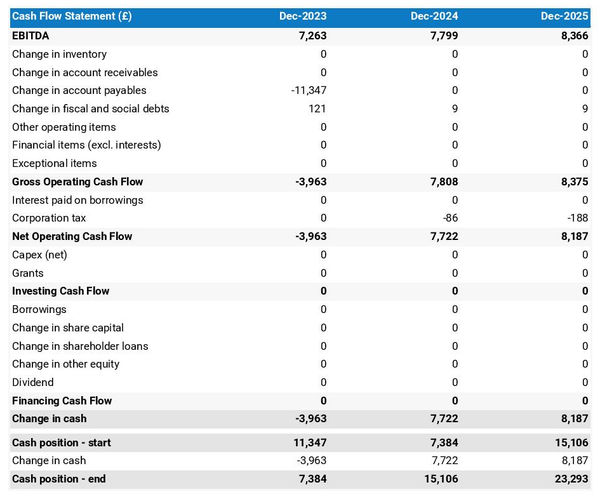
There are multiple ways of presenting a cash flow forecast but from experience, it is better to organise it by nature in order to clearly show these elements:
- Operating cash flow: how much cash is generated by the fast food restaurant's operations
- Investing cash flow: what is the business investing to expand or maintain its equipment
- Financing cash flow: is the business raising additional funds or repaying financiers (debt repayment, dividends)
Your cash flow forecast is the most important element of your overall financial projection and that’s where you should focus your attention to ensure that your fast food restaurant is adequately funded.
Note: if you are preparing a financial forecast in order to try to secure funding, you will need to include both a yearly and monthly cash flow forecast in your fast food restaurant's financial plan.
Need a solid financial forecast?
The Business Plan Shop does the maths for you. Simply enter your revenues, costs and investments. Click save and our online tool builds a three-way forecast for you instantly.

Which tool should you use to create your fast food restaurant's financial forecast?
Creating your fast food restaurant's financial forecast may sound fairly daunting, but the good news is that there are several ways to go about it.
Using online financial projection software to build your fast food restaurant's forecast
The modern and easiest way to build a forecast is to use professional financial projection software such as the one we offer at The Business Plan Shop.
There are several advantages to using specialised software:
- You can easily create your financial forecast by letting the software take care of the financial calculations for you without errors
- You have access to complete financial forecast templates
- You get a complete financial forecast ready to be sent to your bank or investors
- You can easily track your actual financial performance against your financial forecast, and recalibrate your forecast as the year goes by
- You can create scenarios to stress test your forecast's main assumptions
- You can easily update your forecast as time goes by to maintain visibility on future cash flows
- You have a friendly support team on standby to assist you when you are stuck
- It’s cost-efficient and much cheaper than using an accountant or consultant (see below)
If you are interested in this type of solution, you can try our forecasting software for free by signing up here.
Hiring a financial consultant or chartered accountant
Hiring a consultant or chartered accountant is also an efficient way to get a professional fast food restaurant financial projection.
As you can imagine, this solution is much more expensive than using software. From experience, the creation of a simple financial forecast over three years (including a balance sheet, income statement, and cash flow statement) is likely to start around £700 or $1,000 excluding taxes.
The indicative estimate above, is for a small business, and a forecast done as a one-off. Using a financial consultant or accountant to track your actuals vs. forecast and to keep your financial forecast up to date on a monthly or quarterly basis will naturally cost a lot more.
If you choose this solution, make sure your service provider has first-hand experience in your industry, so that they may challenge your assumptions and offer insights (as opposed to just taking your figures at face value to create the forecast’s financial statements).
Why not use a spreadsheet such as Excel or Google Sheets to build your fast food restaurant's financial forecast?
Creating an accurate and error-free fast food restaurant financial forecast on Excel (or any spreadsheet) is very technical and requires both a strong grasp of accounting principles and solid skills in financial modelling.
Most entrepreneurs lack the expertise required to create an accurate financial forecast using spreadsheet software like Excel or Google Sheets. As a result, it is unlikely anyone will trust your numbers.
The second reason is that it is inefficient. Building forecasts on spreadsheets was the only option in the 1990s and early 2000s, nowadays technology has advanced and software can do it much faster and much more accurately.
This is why professional forecasters all use software. With the rise of AI, software is also becoming smarter at helping us detect mistakes in our forecasts and helping us analyse the numbers to make better decisions.
Finally, like everything with spreadsheets, tracking actuals vs. forecasts and updating your forecast as the year progresses is manual, tedious, error-prone, and time-consuming. Whereas financial forecasting software like The Business Plan Shop is built for this.
Need a convincing business plan?
The Business Plan Shop makes it easy to create a financial forecast to assess the potential profitability of your projects, and write a business plan that’ll wow investors.

Use our financial forecast templates for inspiration
The Business Plan Shop has dozens of financial forecast examples available.
Our templates contain both a financial forecast and a written business plan which presents, in detail, the company, the team, the strategy, and the medium-term objectives.
Our templates are a great source of inspiration, whether you just want to see what a complete business plan looks like, or are looking for concrete examples of how you should model financial elements in your own forecast.
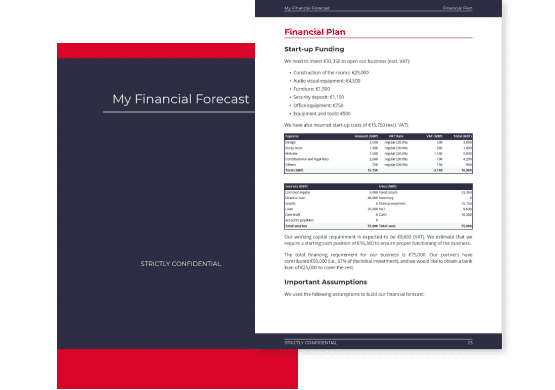
Takeaways
- Having a financial forecast enables you to visualise the expected growth, profitability, and cash generation for your business over the next three to five years.
- Tracking actuals vs. forecast and keeping your financial projections up-to-date is the only way to get a view on what your fast food restaurant future cash flows may look like.
- Using financial forecasting software is the mordern and easy way to create and maintain your forecasts.
This is the end of our guide on how to build the financial forecast for a fast food restaurant, we hope you found it useful. Don't hesitate to contact us if you want to share your feedback or have any questions.
Need inspiration for your business plan?
The Business Plan Shop has dozens of business plan templates that you can use to get a clear idea of what a complete business plan looks like.

Also on The Business Plan Shop
Know someone who owns or is thinking of starting a fast food restaurant? Share our forecasting guide with them!




